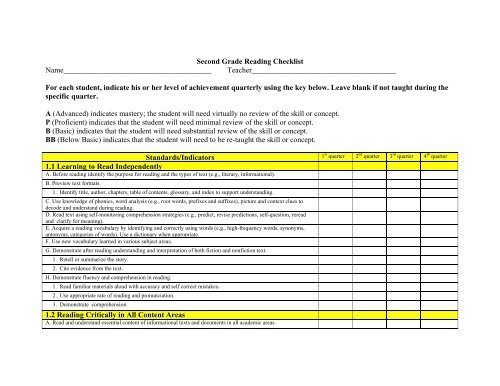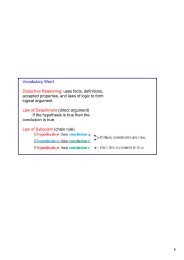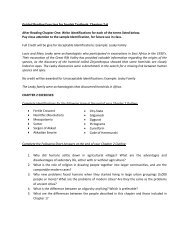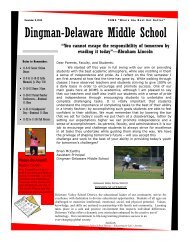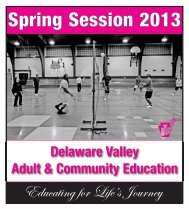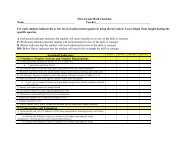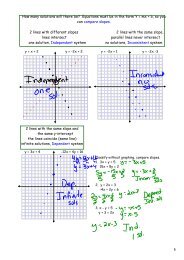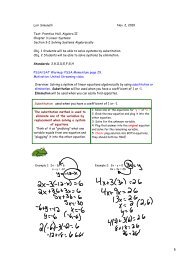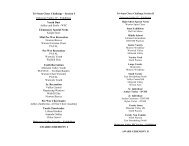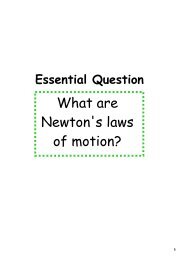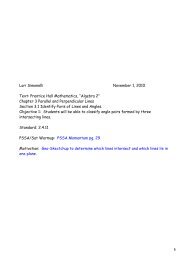Second Grade Reading Checklist
Second Grade Reading Checklist
Second Grade Reading Checklist
Create successful ePaper yourself
Turn your PDF publications into a flip-book with our unique Google optimized e-Paper software.
<strong>Second</strong> <strong>Grade</strong> <strong>Reading</strong> <strong>Checklist</strong>Name_______________________________________ Teacher______________________________________For each student, indicate his or her level of achievement quarterly using the key below. Leave blank if not taught during thespecific quarter.A (Advanced) indicates mastery; the student will need virtually no review of the skill or concept.P (Proficient) indicates that the student will need minimal review of the skill or concept.B (Basic) indicates that the student will need substantial review of the skill or concept.BB (Below Basic) indicates that the student will need to be re-taught the skill or concept.Standards/Indicators 1 st quarter 2 nd quarter 3 rd quarter 4 th quarter1.1 Learning to Read IndependentlyA. Before reading identify the purpose for reading and the types of text (e.g., literary, informational).B. Preview text formats.1. Identify title, author, chapters, table of contents, glossary, and index to support understanding.C. Use knowledge of phonics, word analysis (e.g., root words, prefixes and suffixes), picture and context clues todecode and understand during reading.D. Read text using self-monitoring comprehension strategies (e.g., predict, revise predictions, self-question, rereadand clarify for meaning).E. Acquire a reading vocabulary by identifying and correctly using words (e.g., high-frequency words, synonyms,antonyms, categories of words). Use a dictionary when appropriate.F. Use new vocabulary learned in various subject areas.G. Demonstrate after reading understanding and interpretation of both fiction and nonfiction text.1. Retell or summarize the story.2. Cite evidence from the text.H. Demonstrate fluency and comprehension in reading.1. Read familiar materials aloud with accuracy and self correct mistakes.2. Use appropriate rate of reading and pronunciation.3. Demonstrate comprehension.1.2 <strong>Reading</strong> Critically in All Content AreasA. Read and understand essential content of informational texts and documents in all academic areas.
1. Identify facts and opinions.2. Distinguish between essential and non-essential information within a text.3. Make inferences and draw conclusions from text in all content areas.4. Use appropriate comprehension strategies to construct meaning.B. Identify and use a variety of media to gain information (e.g., computer, tape recorder, television, videos, DVD’s andvarious computer media).1. Use electronic media to develop a project.2. Use electronic media to present a project.C. Produce work in one form of genre (e.g., biographies, poems, tales, mysteries, fables).1.3 <strong>Reading</strong>, Analyzing and Interpreting LiteratureA. Read and understand a variety of works of literature.B. Identify literary elements in stories describing characters, setting, and plot.C. Identify literary devices in stories (e.g., rhyme, rhythm, personification).D. Identify the structures in poetry (e.g., pattern books, predictable books, nursery rhymes).E. Identify the structures in drama (e.g., story action, dialogue).F. Read and respond to nonfiction and fiction.1.4 Types of WritingA. Write narrative pieces. Include basic descriptions of people, places and things. • Use relevant illustrations. • Include asimple plot.B. Write an informational paragraph about a topic (e.g., letters, reports, descriptions, instructions) using illustrations whenrelevant.C. Write an opinion and support it with two or more facts.1.5 Quality of WritingA. Write with a distinct focus, identifying the topic, purpose, and audience.B. Write using content appropriate for the topic. • Gather and organize information. • Write a series of relatedsentences with one central idea. • Incorporate details relevant and appropriate to the topic.C. Write with a recognizable organization. • Sustain a sequence of events in chronological order using key words(e.g., first, next, then, finally). • Include a beginning, middle, and end.D. Write with an awareness of style. • Experiment with sentences of differing length and type.1. Use descriptive words and action verbs.E. Revise writing to improve detail and order by identifying missing information and determining whether ideasfollow sequentially and logically.F. Edit writing using the conventions of language.
1. Spell common, frequently used words correctly. • Use capital letters correctly (first word in sentences, “I”, andnames of people and places).2. • Use proper end punctuation (period, question marks, and exclamation point).3. • Use nouns, pronouns, verbs, and adjectives properly.4. • Use complete sentences.G. Present and/or defend written work for publication when appropriate.1.6 Speaking and ListeningA. Listen to others.B. Listen to a selection of literature (fiction and/or nonfiction).1. • Relate it to similar experiences. • Predict what will happen next. • Retell in sequential order.C. Present ideas using appropriate speaking skills.D. Contribute to discussions by asking related questions in order to gain information, clarify thinking, and understandothers and respond with related information or opinions to questions asked.E. Participate in small and large group discussions and presentations.1.7 Characteristics and Functions of the English LanguageA. Recognize that some words from other languages are commonly used English words.B. Identify variations in the dialogues of literary characters. Recognize that appropriate language varies according to setting.1.8 ResearchA. Select a topic for research.B. Locate information using appropriate sources and strategies.1. Identify various sources of information (e.g., dictionary, appropriate level newspapers and magazines,encyclopedias, electronic media).2. Select sources (e.g., dictionaries, encyclopedias, observations and electronic media).3. Use table of contents, key words and guide words.C. Organize and present the main ideas from the research.D. Write draft using information from source(s).


